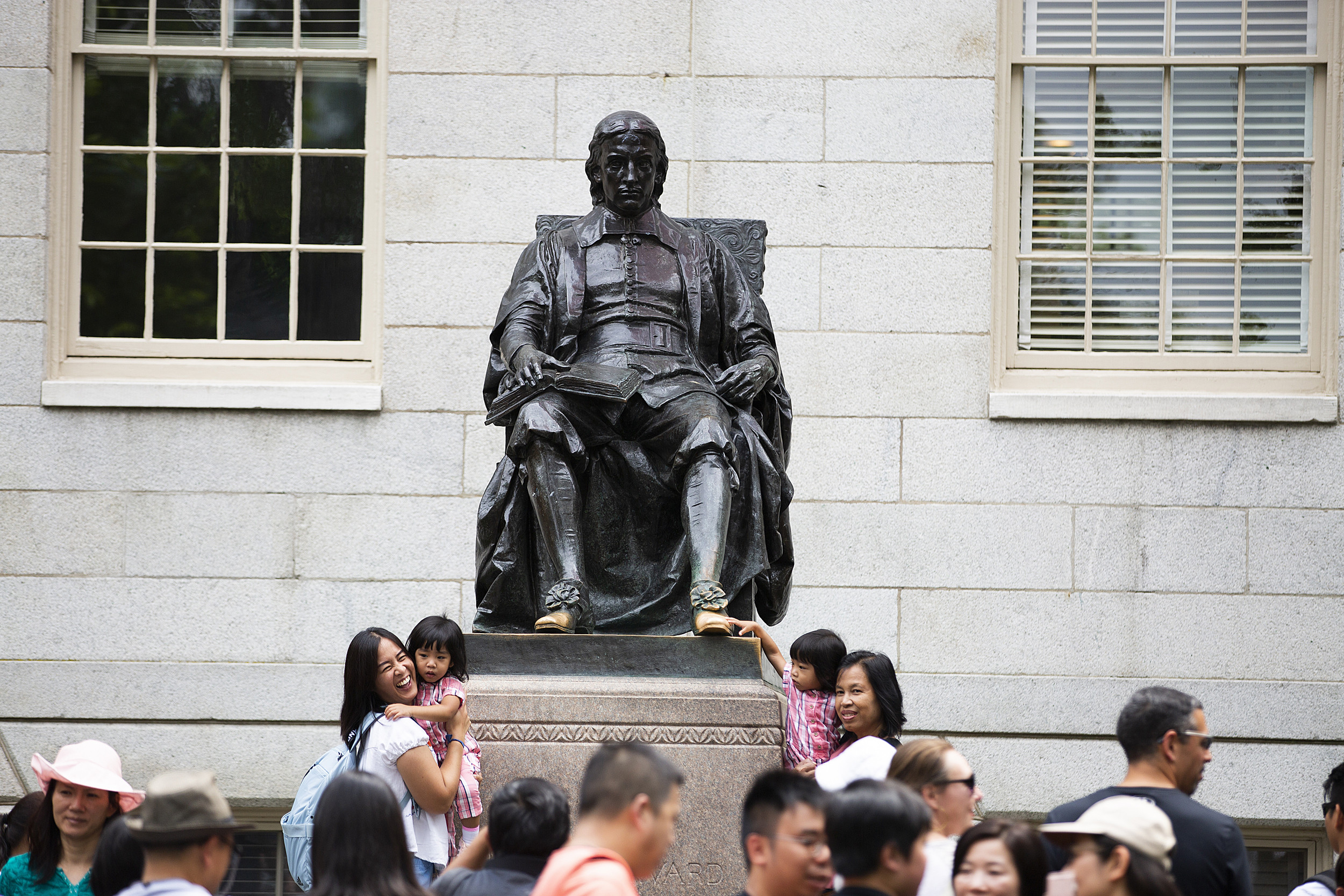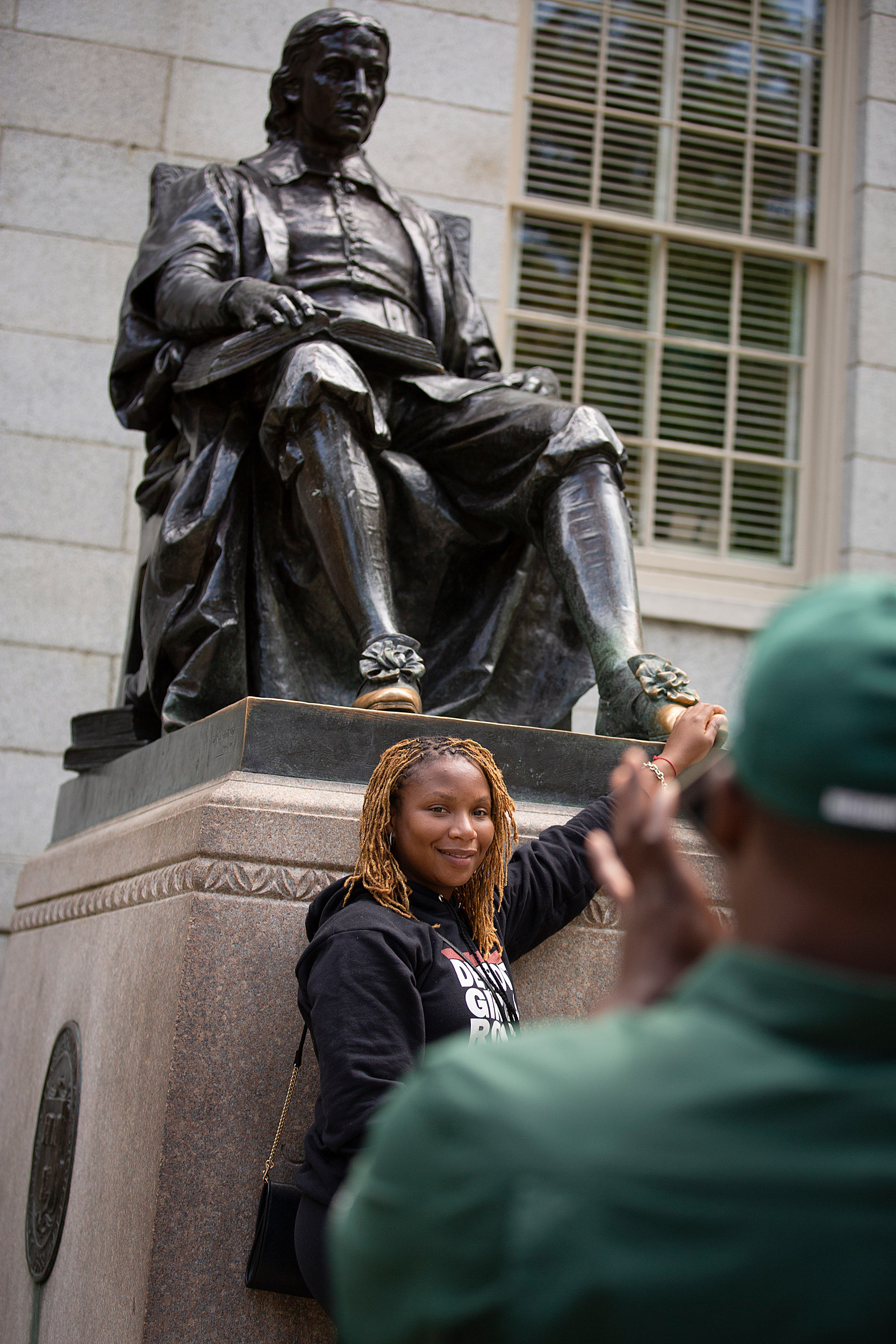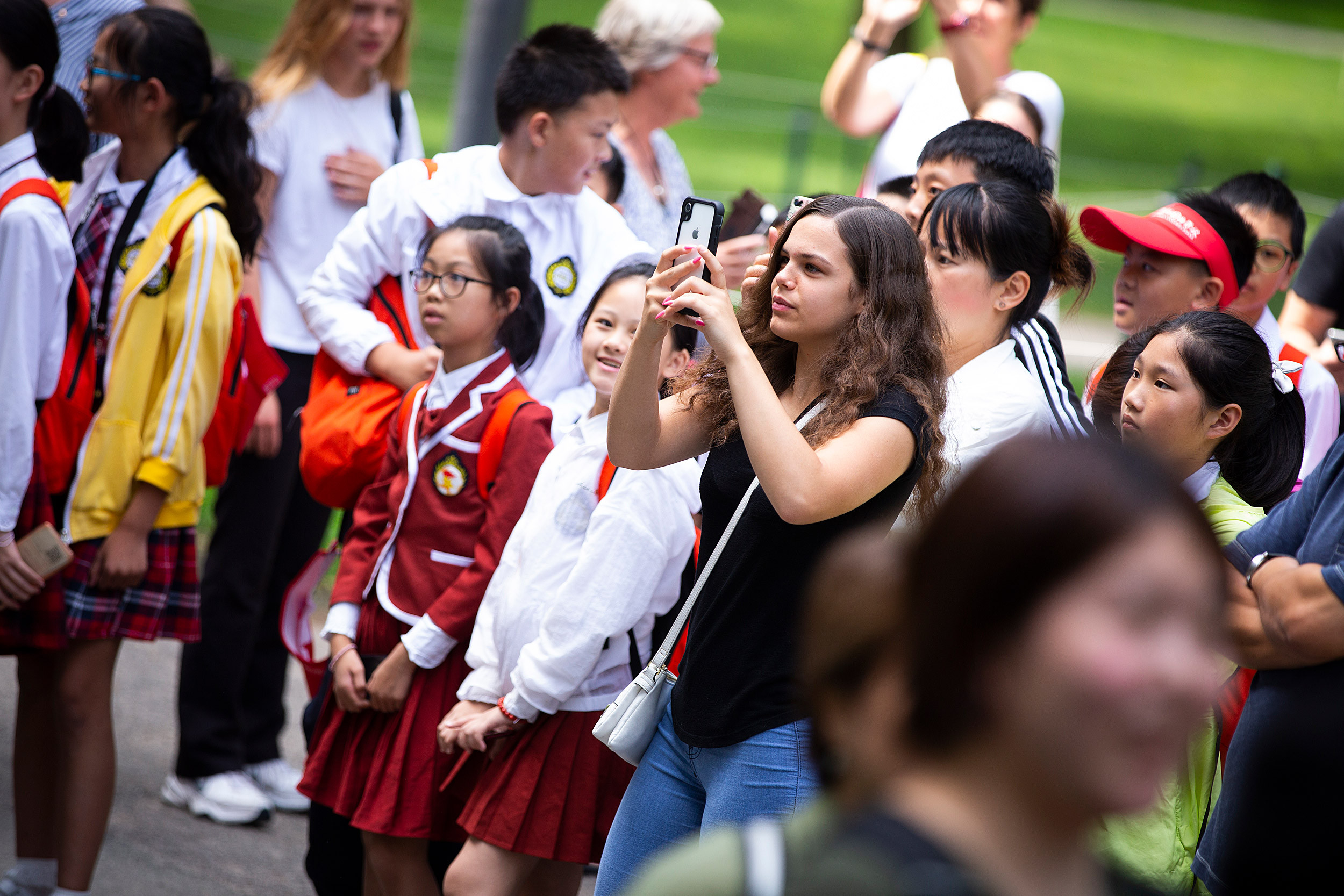If you’re looking for the heart of Harvard University, just follow the crowd. At almost any time of day, you’ll find clusters of people gathered in Harvard Yard, cameras and phones in hand, all focused on a single point: the John Harvard Statue. From solo selfies to bustling group photos, this bronze figure is undeniably Harvard’s star attraction, and a must-see for anyone visiting Greater Boston.
“We’re tourists,” Sandra Coh from France explained, perfectly summing up the sentiment of many as she visited with her family. “We visit and we take pictures.” And indeed they do. A quick search on Instagram for “John Harvard Statue” reveals a seemingly endless stream of photos, a testament to its status as one of the most photographed statues in the United States. Some lists even place it as high as number three. The visitors are a diverse mix: tourists from across the globe, prospective students soaking in the campus atmosphere, and newly admitted Harvard students celebrating their achievement.
 Visitors gather around the John Harvard statue in Harvard Yard, some lifting children to touch the famous foot.
Visitors gather around the John Harvard statue in Harvard Yard, some lifting children to touch the famous foot.
Tour guide Maddie Earle, during one of Harvard’s historic tours, encouraged her group to capture as many memories as they wished with the statue. Built in 1884, she explained the popular tradition: touching the statue’s left foot, now gleaming gold from countless interactions, is said to bring good luck.
 Tourists share laughter and moments as they reach out to touch the bronze feet of the John Harvard statue.
Tourists share laughter and moments as they reach out to touch the bronze feet of the John Harvard statue.
Tia Jackson, a visitor on campus, takes her turn to partake in the iconic tradition, reaching out to touch the famed bronze shoe.
 A visitor, Tia Jackson, carefully touches the left foot of the John Harvard sculpture.
A visitor, Tia Jackson, carefully touches the left foot of the John Harvard sculpture.
Beyond individual tourists, numerous local tour companies incorporate the Harvard campus, and specifically the statue, into their itineraries. Harvard itself offers official historic tours, and the student-led Hahvahd Tour is another popular option, all ensuring the John Harvard Statue remains a central point of interest.
However, some visitors approach the statue with a deeper curiosity. Raju Psn, visiting from Hyderabad, India, lingered, meticulously studying the artistry of Daniel Chester French, the sculptor also renowned for the Lincoln Memorial statue. Psn observed the details – the skullcap, the collar tassels, the subtle mustache. He examined the floral bows on the shoes and knelt to appreciate the seals on the granite plinth: those of Harvard College and Emmanuel College, where John Harvard earned his degrees.
 The John Harvard statue stands prominently in Harvard Yard, with the historic buildings forming a picturesque backdrop.
The John Harvard statue stands prominently in Harvard Yard, with the historic buildings forming a picturesque backdrop.
Unaware of the statue’s or John Harvard’s history, Psn nonetheless recognized the bronze figure as an embodiment of the University’s essence. “It’s an inspirational place,” he reflected. “It gives us energy.”
 A visitor expresses his inspiration, stating "It's an inspirational place. It gives us energy," while standing near the John Harvard Statue.
A visitor expresses his inspiration, stating "It's an inspirational place. It gives us energy," while standing near the John Harvard Statue.
Families too, participate in the tradition. A father helps his young son reach up to touch the statue, continuing the cycle of interaction and lore.
 A father carefully holds his 6-year-old son so he can touch the foot of the John Harvard statue, participating in the popular tradition.
A father carefully holds his 6-year-old son so he can touch the foot of the John Harvard statue, participating in the popular tradition.
Another father hoists his 7-year-old son to ensure he can reach the coveted foot of the statue, demonstrating the lengths visitors go to engage with the landmark.
 A father lifts his 7-year-old son high so he can touch the foot of the John Harvard statue, highlighting the statue's appeal across generations.
A father lifts his 7-year-old son high so he can touch the foot of the John Harvard statue, highlighting the statue's appeal across generations.
Yixi Tang, 6, and Theodore Dearaujo, 7, receive assistance from their fathers, Tom and Thiago, to partake in the tradition, illustrating the statue’s intergenerational appeal.
 Amidst a crowd of onlookers, a visitor holds up her cellphone to capture a photo of the John Harvard statue, documenting their visit.
Amidst a crowd of onlookers, a visitor holds up her cellphone to capture a photo of the John Harvard statue, documenting their visit.
It’s fortunate Raju Psn didn’t encounter Maddie Earle during his contemplative visit. “That’s not John Harvard,” Earle informed her tour group, revealing the local nickname for the statue: “the statue of three lies.”
Earle proceeded to debunk the statue’s perceived accuracy. Firstly, it doesn’t actually depict John Harvard. All authentic portraits of the University’s benefactor were lost in a fire in 1764. Instead, sculptor Daniel Chester French used Sherman Hoar, a member of the Harvard Class of 1882 and a relative of a former Harvard president, as his model. “It is a tradition here at Harvard to name Houses after former presidents,” Earle explained, adding a touch of Harvard lore, “They didn’t want to name a House after [Leonard] Hoar for obvious reasons, so they decided to use his nephew as a regal-looking figure to commemorate John Harvard.”
The second “lie,” Earle clarified, is that John Harvard was the University’s founder. In reality, he was a significant early benefactor, whose donation of books and estate was crucial in the institution’s early days. And the third falsehood? The inscription on the statue states Harvard College was founded in 1638, not the accurate year of 1636.
Despite these historical inaccuracies, or perhaps even adding to its charm, the tradition of touching the left foot for good luck persists. This lore is often passed on organically among visitors. Nacho Ruiz from Spain, visiting with Eric Peoples from Detroit, was overheard sharing his version of the legend: failing to touch the foot guarantees you’ll never finish college. “But I don’t know. I’m a tourist,” Ruiz admitted with a laugh, highlighting the playful nature of the myth. Regardless of its veracity, Peoples ensured his daughter, Tia Jackson, captured a photo touching the foot.
 A couple with their 9-month-old baby pose for a photo at the base of the John Harvard statue, participating in the tradition as a family.
A couple with their 9-month-old baby pose for a photo at the base of the John Harvard statue, participating in the tradition as a family.
Families from around the world make a point to visit and interact with the statue. Marco Mayolo and Tatiana Espinosa from Colombia, with their son Santiago, and Abdolreza Osouli and Shadi Ansari from Tehran, with their son Aurian, are just a few examples of the statue’s global appeal.
 A family from Tehran, Iran, poses proudly by the John Harvard statue, making it a part of their Harvard experience.
A family from Tehran, Iran, poses proudly by the John Harvard statue, making it a part of their Harvard experience.
Sammota Mwakalobo ’20, a Harvard student from Tanzania, leading a tour group of young Japanese students, offered a student’s perspective on the tradition. “It’s the iconic thing to do,” she explained. “It’s as though your experience would be lacking something if you didn’t.” For her, taking a photo with the statue marked the beginning of her Harvard journey. Whether for luck, tradition, or simply to capture a quintessential Harvard moment, the John Harvard Statue remains an enduring symbol, drawing crowds and sparking curiosity in the heart of Harvard Yard.
“It’s the iconic thing to do. It’s as though your experience would be lacking something if you didn’t.”
Sammota Mwakalobo, pictured below leading a tour
 Sammota Mwakalobo guides a tour group near the John Harvard statue, sharing insights and history with visitors.
Sammota Mwakalobo guides a tour group near the John Harvard statue, sharing insights and history with visitors.
